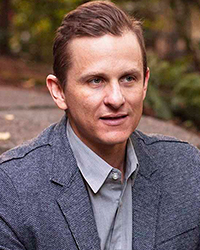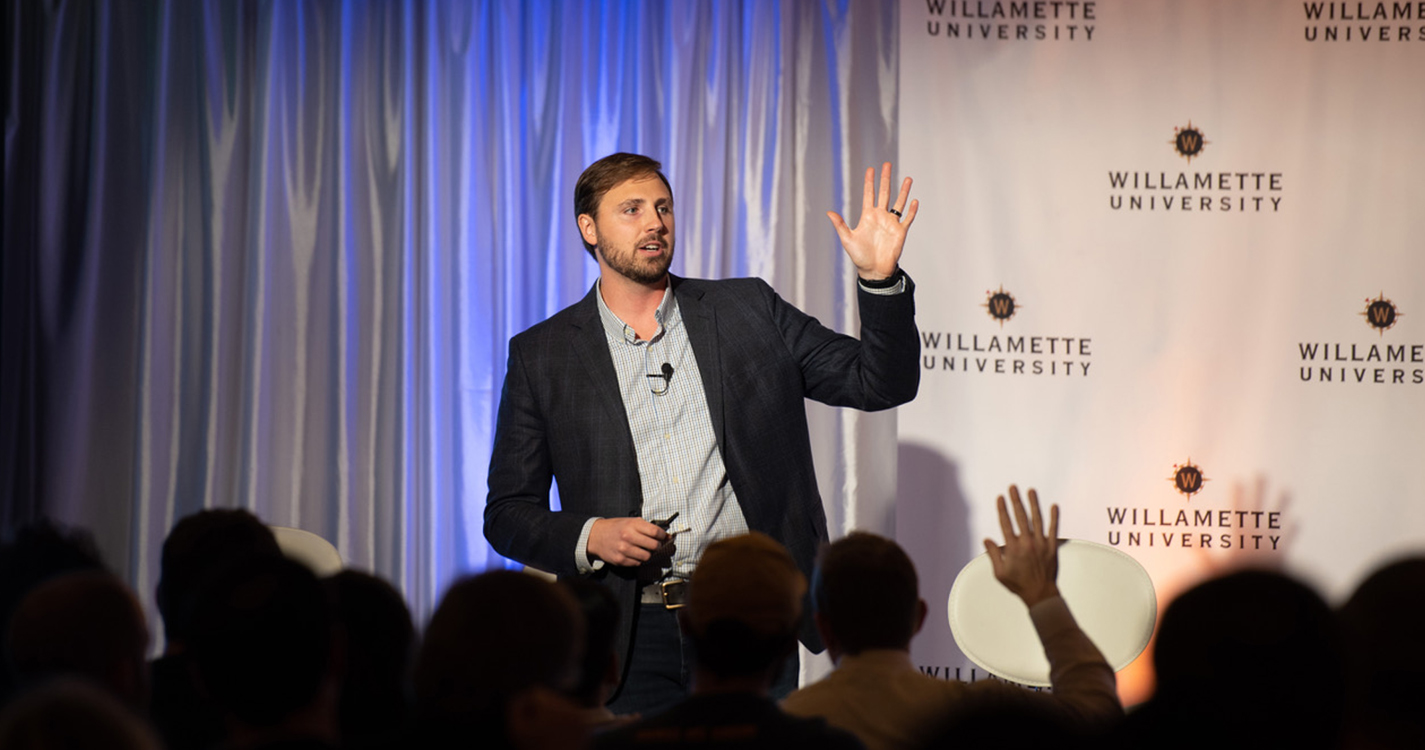In 2009, Bitcoin creator Satoshi Nakamoto carried out the first cryptocurrency transaction — a transfer of digital money administered not by a financial corporation but by a decentralized network of computers. Since then, Litecoin, Ethereum and thousands more digital currencies have used the same technology to build volatile but exciting trading markets, untethered from the analog world of banks and national economies.
Blockchain, the technology behind crypto, uses a combination of digital cryptography and distributed computer networks to create transparent and highly secure ledgers. These databases can store and manage information related to anything from Bitcoin transactions to food supply chains. While many are skeptical that digital currencies will democratize money, there is little doubt that blockchain has massive business potential.
Fairer trade
One company banking on the mass adoption of cryptocurrencies is Seattle’s Coinme, which launched the United States’ first licensed Bitcoin ATM in 2014. From the same offices that once housed Napster, Coinme now runs a network of 2,000 digital currency kiosks, enabling consumers to buy or sell up to $2,500 of Bitcoin at a time.
According to CEO Neil Berquist ’09, MBA ’10, Coinme’s goal is to build public trust in digital currencies and make crypto more accessible.
“Consumers are used to walking into a bank, establishing trust and then giving money to that institution. Whereas, in the world of digital currency, consumers were expected to go online to some random website and wire money to an account. Well, that doesn’t create trust,” Bergquist said.
A kiosk in a brick-and-mortar space “helps bridge the gap between ‘magic internet money’ and consumer trust.”
But the company’s ATMs are “just a piece of the overall digital currency ecosystem that we’re building,” he added.
On the tech side, Coinme provides a mobile wallet (an application that enables customers to use their crypto) and, for higher-stakes clients who wish to purchase more than $2,500, a private client financial advisory team.
Cryptocurrency first caught Bergquist’s attention in 2012, when he was running SURF Incubator in Seattle, home to around 1,200 budding tech entrepreneurs.
“It was just a curiosity, but like any curiosity, it led me to learn more,” he said.
Friend and future Coinme cofounder Michael Smyers had just read about the world’s first Bitcoin ATM in Vancouver, British Columbia, and, “out of his excitement, he bought three of them, blindly, from the manufacturer,” Berguist said.
The next step was working with the Washington State Department of Financial Institutions to help revise state finance laws to incorporate crypto. Not long after that, the company had a license to open its first kiosk. The three kiosks found homes near SURF, in Startup Hall at the University of Washington and at the Southcenter Mall south of Seattle.
For the first year, Bergquist and Smyers mapped out and tested assumptions about a Bitcoin kiosk business — were people going to use the ATM? Would it get hacked or stolen? Would they face legal issues because it was not federally regulated?
It worked out.
“I didn’t go to jail, we didn’t get hacked, people did use them,” Bergquist said.
As of 2019, Coinme operates in 30 states and 150 countries. A new partnership with ATM company Coinstar will also see the integration of their software into 20,000 additional machines in North America and Europe. Rather than spending decades building and distributing ATMs, Bergquist realized that “we might as well leverage the existing infrastructure and achieve scale much faster.”
Like Bergquist, Coinme’s Head of Private Client Services Nathan Love ’05, MBA ’06 attended the Atkinson School of Graduate Management (AGSM). Before joining the company, Love had been working for DVR company TiVo in New York City.
“The cable industry has been nosediving for the last couple of years, so it was hard to motivate a sales team on a product where the long-range plan is losing 20 to 25 percent of its subscribers year over year,” Love said.
So when Bergquist asked his classmate to join the Coinme team, it seemed like an exciting prospect. Now, Love leverages the benefits of cryptocurrency to make investment easier, more secure and cheaper for their clients.
When consumers use a company such as Western Union to transfer money internationally, for example, “they’re carving out 10 to 12 percent. Even credit card companies charge 2 to 5 percent,” Love said. “Cryptocurrency transactions can be done for a fraction of that cost — pennies, really.”
Wherever national currencies are crashing, crypto can also help, according to Bergquist.
In the United States, a dollar is likely to hold its value from one day to the next. In countries where the fiat currency is unstable — Venezuela, Argentina or South Africa, for example — people just want “a fair form of money that’s not under the control of some erratic leader or subject to the price of oil.”
While Coinme doesn’t claim that cryptocurrencies are inherently more stable than government-backed money, they can “create alternative stores of value, whether that’s pegged to the U.S. dollar or Bitcoin or gold or diamonds,” Bergquist explained.
For Love, the crypto learning curve was steep. Most surprising was the amount of fraud in the industry, but also the fact that crypto has been the best-performing investment asset class over the last five years.
Still, he would not recommend that clients sink their life savings into Bitcoin.
“We had a woman who was a schoolteacher. She was retired and wanted to put her whole pension into a crypto. We said: No, that’s too much of a risk for you,” he recalled. As a starting point, he and his team generally recommend that crypto investments be around 3 to 7 percent of your current retirement investment.
Love’s next step is building his department and learning more about this unpredictable industry.
“There’s demand for the product,” he said. “We’re helping solve a problem for people, and I’m running a sales team where they’re excited about something.”
Money talk
Unlike Love and Bergquist, Willamette Professor of Economics Don Negri is deeply skeptical of cryptocurrencies’ democratizing potential.

“It’s just a reallocation of wealth rather than a creation of anything useful,” Negri said. “It’s moving money from pocket to pocket rather than the production of goods and services that provide a greater welfare to the economy.”
He also doubts that crypto can replace government-backed currency. In fact, it may not even qualify as money. Why? Money, he offered, has three defining characteristics: it is a medium of exchange, a store of value and a unit of account.
“Some of these crypto currencies do act as a medium of exchange; however, there are drawbacks,” Negri said.
Understanding these drawbacks requires delving further into blockchain technology. Blockchain allows for digital data to be stored permanently and in a publicly accessible ledger or database. Bitcoin, for example, packages data related to multiple crypto transactions — who is sending how much money and to whom — into one “block.” That block is then validated by a distributed network of computers and added to the blockchain, a string of individual blocks that are linked together. Each computer in the network maintains a copy of the blockchain. (See how blockchain works.)
Negri pointed out that it takes 10 minutes for a Bitcoin block to be created and then up to an hour for the transactions in the block to be validated. “So if I walk into your place of business and I pay with Bitcoin, I can walk out before the transaction’s actually verified, and that is a drawback in terms of [being a] medium of exchange.”
As a store of value, crypto is also highly volatile. In fall 2017, one Bitcoin was worth around $20,000. A year later, it was worth closer to $4,000.
“So those are two ways in which I would characterize cryptocurrencies as assets” rather than money, Negri said. (The Internal Revenue Service agrees: when doing your taxes, Bitcoin counts as a digital asset.)
The most dangerous downside is that data inside a crypto block cannot be altered after the block has been created. On the one hand, this makes for highly secure recordkeeping. However, it also means that transactions are irreversible and there is no way to get your money back in the case of fraud. CNBC reported that, in the first half of 2018 alone, $1.1 billion in Bitcoin was stolen due to this irreversibility problem.
Some enthusiasts also claim that crypto is immune to inflation. In this regard, Negri is “old school.”
“I like the fact that the Fed can control and manipulate the money supply and connect it to the state of the economy, as we’ve seen in the last decade with the Fed increasing the money supply, lowering the interest rates and bringing us out of a rather deep recession.”
He does, however, acknowledge the technology’s enormous potential. Its ability to track and store data, as well as its resistance to hacking, make it a powerful business tool. Take supply chain management, for example.
“If I were interested in purchasing sustainable wood to build the deck in my backyard, the blockchain technology enables the supply chain to track the ownership of that wood from forest to final owner,” he said. But as excited as he is about the efficiencies that blockchain might infuse into the economy, Negri still worries that digital currencies will only exacerbate wealth inequality.
“My experience with the creation of lots of wealth in the past is that it has gone to a rather small percentage of Americans,” he said. “And that is not healthy for our democracy.”

Negri’s colleague Jameson Watts, assistant professor of marketing, considers cryptocurrency “the first application of blockchain technology that people find useful.”
Watts is primarily interested in how individuals might use blockchain to protect their privacy and retain more control over the data they provide to organizations. Imagine that a company uses blockchain to track prospective customers.
“I could, for instance, register that I have an interest in learning more about refrigerators and various refrigerator manufacturers can bid for my attention,” Watts said. “Rather than paying Google, CNN or some other media outlet for the privilege of advertising to someone like me, they can pay me directly to advertise to exactly me.”
The monetary value of this would likely be less than one cent, making it a payment that traditional financial institutions could not process. Here is where crypto comes in: Transferring digital currencies requires no minimum transaction amount and is essentially free, so businesses could pay each consumer directly for their attention.
“Part of the reason that we’ve had large organizations and firms is because it is a costly endeavor for me to trade directly with you,” Watts said. “If you think about a system like blockchain reducing the cost of transacting in the marketplace, then we’ve now got a world where the size of the firms can shrink and we get closer to a producer-to-producer system of exchange.”
Though Watts isn’t willing to bet on any one digital currency: “If I could buy an index fund of all the various cryptos that are out there, I would be into it, because I believe that the technology is important as a way to make exchanges.”
A digital infrastructure
It was J.R. Willett’s father who first inspired him to think about building infrastructure around cryptocurrency. When the software engineer and tech entrepreneur told his dad about the burgeoning field of digital money, Willett senior made the traditional comparison to the gold rush, but with a twist.
“He said, ‘The people that really made a lot of money were not the guys out digging in the hills but the guys that were selling picks and shovels,’” Willett said. “I started contemplating. Well, what does infrastructure look like in cryptocurrency?”
The answer was the Omni protocol layer, a set of code which Willett built on top of the code that created Bitcoin.
Protocol layers are sets of code that can be “layered” on top of one another to add increasingly complex functionality. The internet, for example, is composed of multiple protocol layers — ones that enable networking, as well as ones that allow for emailing or creating webpages, for example.
With no time or money to develop Omni himself, Willett instead created a digital “token.” He asked crypto enthusiasts to send Bitcoin to an address associated with that token and he then used that funding to hire developers to build Omni for him. In return, anyone who had contributed owned a stake in that protocol, in the same way that an investor owns part of a startup business.
Since then, that process, known as a token sale or initial coin offering (ICO), has been taken up by blockchain businesses around the world, raising the equivalent of more than $10 billion to accelerate blockchain applications.
“I didn’t think I was revolutionizing anything. I was just trying to solve a problem,” Willett said. “Only in retrospect did people look on that as some sort of major first step in a new direction for financing or crowdfunding.”
Willett is now working with the Coinme team on a token-based product. UpToken is a kind of rewards points system for Coinme’s ATM users. With each withdrawal, a consumer receives one percent “cash back.” After $10,000 in withdrawals, the UpTokens can be used to get a discount on subsequent ATM fees or to participate in Coinme elections that determine which cryptocurrencies the company adds to its kiosks.
This agnostic approach to which crypto will win out appealed to Willett when he signed on.
“This was an opportunity to get involved in something that not only was picks and shovels, but was also completely resilient to what kind of gold we’re digging for.”
When Willett invented the ICO, he also unleashed a swath of new legal questions. Lawyer Jason Gershenson JD ’11 has spent a lot of time thinking about tokens and the future of blockchain as an associate at the New York and Portland offices of White Summers Caffee & James, LLP, where he advises startups and established businesses on how to successfully and legally implement blockchain projects.
Gershenson’s interest in digital currencies emerged in 2013, thanks to Reddit. But it was his first Bitcoin meetup in Portland that made a real impact.
“There were about two dozen people there. When I walked in, they were all crowded around these two gentlemen sitting across the table from each other. One had a QR code on his phone and the other had $10,000 in cash to make an exchange to purchase Bitcoin,” Gershenson said.
“Seeing that kind of value being placed on this and seeing everyone kind of in awe at this transaction happening was eye-opening.”
After delving into crypto and its applications, he saw both huge potential and significant legal risk.
“Law can be really dry sometimes. But this was attractive, because it was so nontraditional. I was just excited to see how things would change to accommodate blockchain,” he said.
Tokens can pose particularly tricky legal situations.
Last November, for example, the U.S. Securities and Exchange Commission (SEC) ruled that Zachary Coburn, the founder of crypto token trading platform EtherDelta, had created an unregistered securities exchange. Though Coburn made an income from the platform, “he had minimal participation in facilitating the transactions themselves, other than having written the self-executing code,” Gershenson said. So the question became: Does writing the code create liability?
“At least right now, the SEC is leaning toward yes.”
Gershenson recognizes the importance of consumer protections in the field. According to one study, the value of all tokens in the marketplace decreased by 75 percent, or $600 billion, between January and August last year. However, he is also excited at the prospect of blockchain making it easier to become an investor.
“Personally, I love the notion that people could purchase tokens without the barrier to entry of being an accredited investor or of the company going through the high cost of registering with the SEC. That opens the door for people,” he said.
And he is one of the few who see mass crypto adoption coming soon.
“I don’t think it’s crazy for there to be a U.S.-backed currency on the blockchain,” he said. “And I think we’ll see companies like Starbucks have their token that’s going to provide benefits and rewards and free drinks.”
A blockchain future
In Robert Walker’s blockchain future, crypto plays a smaller role.

“I think a lot of the most interesting applications of blockchain are out of general view,” said Walker, associate professor of quantitative methods. “And that’s because cryptocurrency you can get people excited by, but romaine lettuce is harder to excite people about.”
While crypto gets the media attention, using blockchain to track produce in a supply chain — something that French retail giant Carrefour is currently implementing — is “deeply useful for humanity.”
Walker, like many, caught the blockchain bug and dove into the literature, but his interest was in the algorithms rather than the hype. After building his own basic blockchain, he started to understand the technology’s utility.
“It’s a better way of thinking about the way we decentralize the collection and systemization of information,” he said. “On a very, very large scale, blockchain is a revolutionary way of thinking about version control.”
For most companies, Microsoft Excel and similar applications are a primary tool for data management. But blockchain provides a more powerful solution. Why? Spreadsheets get edited, versions disappear and data are lost. With blockchain, on the other hand, every change is stored and every version exists within the network.
It’s a lot like the cloud computing revolution, Walker added, except “instead of it being me securely interacting with my own data, what we’re talking about is the potential for this giant decentralized cloud where nothing is ever forgotten.”
And where irreversibility is a problem for crypto transactions, for a data scientist, it is a huge boon.
“The first incontrovertible principle of data is supposed to be its immutability,” he said. Given its transparency and comprehensiveness, blockchain “allows us to think about doing data analysis with integrity, because it makes it entirely transparent how we go from input to output.”
In this sense, Walker argued, while it may not democratize money, it could democratize information. A side effect for consumers may be the elimination of “middle men” jobs — title companies who charge a fee to check home ownership records or businesses who use data to create and then sell credit scores.
“There’s a lot of revenue generated by combining data in a variety of different ways and making it easily accessible to end users. One of the things that I think the blockchain potentially promises is the elimination of all of those as a kind of revenue sources,” said Walker. “And it doesn’t strike me that there’s any way, from a global human efficiency standpoint, that it’s not better to make them obsolete, because it currently creates barriers to people accessing information.”
According to Bergquist and Love, opportunity is also at the heart of the Coinme model.
“Our mission is really focused on giving consumers access to participate in the digital economy,” Bergquist said.
Making crypto readily available, easy to use and simple to understand is also the only way to combat the negative media coverage of digital currencies.
“The media doesn’t write an article about someone who bought a Tesla and loves it; the media will write an article about someone who bought a Tesla that caught on fire, because it creates clicks and impressions and drives revenue for whoever wrote the article,” Bergquist said.
Love points out, too, that business adoption of blockchain is happening in part because crypto has made it exciting. IBM and Microsoft have already developed enterprise blockchain applications. Companies like Daimler have offered bonds using this new technology. The Australian stock exchange plans to launch the world’s first industrial-scale blockchain in 2020.
“Crypto helps build the blockchain and really show that it’s an organized ledger where you can trace something all the way back to where it originated,” he said.
While he doesn’t know exactly what the future of this technology will hold, “you’re going see a lot more companies embrace it, and that’s only a positive thing,” Love said. “And then as soon as guys like Amazon or Facebook create their own coin, as soon as they start accepting cryptocurrency transactions; that’ll be kind of the next really big wave.”
How blockchain works
What is blockchain?
A blockchain is a series of digital “blocks” linked together using computer cryptography. Each block contains data. Data in a block cannot be changed after the block has been created.
A Bitcoin block, for example, includes information on a transaction — the amount, who the sender is and who the recipient is. In the corporate world, blockchain has been adapted to monitor things like supply chains. This way, companies can track produce from its origin to the consumer.
Blocks are created by a distributed network of computers, or nodes. Each node also stores a copy of the blockchain, a sort of shared ledger of records, which goes back to the first block.
How are new blocks created?
First, all the nodes in a network check the data being added to a block. A majority must agree that the information is legitimate. Each blockchain has its own rules for this verification process.
Once verified, all the data in a single block are converted into one 40-character alphanumeric hash code. This unique hash code is a block’s digital fingerprint.
When a new block is created, it includes its own unique hash and a copy of the hash for the previous block in the chain. This securely links every block in the blockchain to its predecessor.
What makes blockchain secure?
Hash codes: Anyone who fraudulently alters data in a block will cause its hash code to change. If block 3 suddenly has a new hash code that does not match the copy of that hash stored in block 4, the blockchain is broken.
The decentralized network: Nodes can check their own copies of the blockchain to reverify potentially fraudulent activity. The network resolves the problem by reverting to a previous version of the blockchain with no invalid transactions.
The amount of computer processing hackers would need: Successfully hacking a blockchain would require changing one block, recalculating hash codes for all subsequent blocks and getting a majority of nodes to verify those changes.


